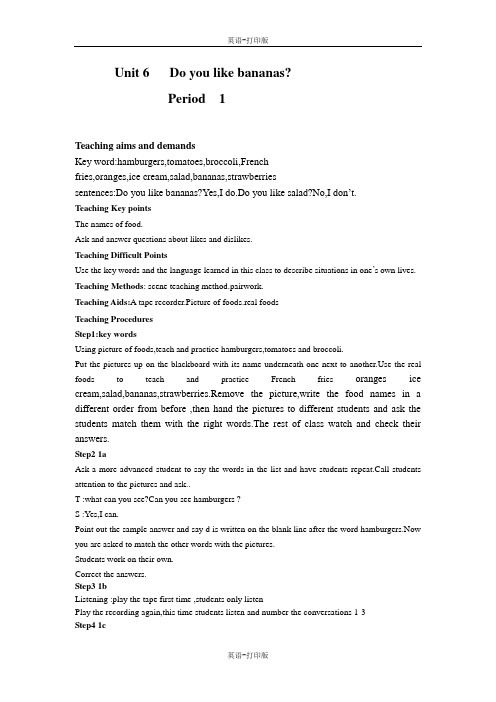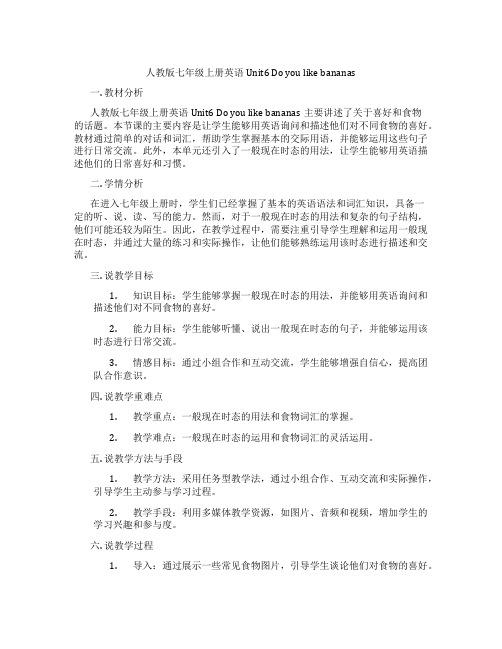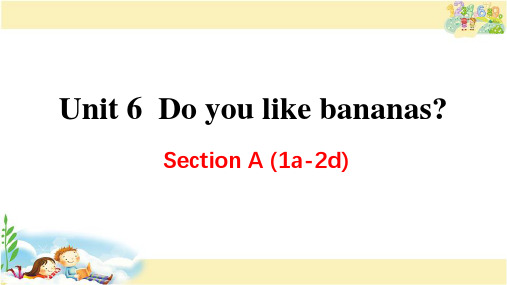人教版英语七上unit 6Do you like bananas (Period2)(共30张PPT)
- 格式:ppt
- 大小:2.99 MB
- 文档页数:20

Unit 6 Do you like bananas? 讲义一、【重点单词】banana /bə'nɑ:nə/香蕉hamburger /'hæmbɜ:(r)ɡə(r)/汉堡包tomato /tə'mɑ:təʊ/西红柿ice-cream /,aɪs'kri:m/冰激凌salad /'sæləd/沙拉strawberry /'strɔ:berɪ/草莓pear /peə(r)/梨milk /mɪlk/牛奶bread /bred/面包birthday /'bɜ:(r)θdeɪ/生日dinner /'dɪnə(r)/(中午或晚上吃的)正餐week /wi:k/周;星期food /fu:d/食物sure /ʃʊə(r)/当然;肯定;一定burger /'bɜ:(r)ɡə(r)/汉堡包= hamburgervegetable /'veʤtəbəl/蔬菜fruit /fru:t/水果right /raɪt/正确的;适当的apple /'æpl/苹果then /ðen/那么egg /eɡ/蛋;鸡蛋carrot /'kærət/胡萝卜rice /raɪs/大米;米饭chicken /'ʧɪkɪn/ji鸡肉so /səʊ/ (引出评论或问题)那么breakfast /'brekfəst/早餐;早饭lunch /lʌnʧ/午餐star /stɑ:(r)/明星;星星eat /i:t/吃well /wel/好;令人满意的habit /'hæbɪt/习惯healthy /'helθi/健康的really /'ri:əli/真正地question /'kwesʧən/问题want /wɒnt/需要;想要be /bi:/变成fat /fæt/肥的;肥胖的二、【重点短语】1. John ’s birthday dinner 约翰的生日宴会2. vegetable salad 蔬菜沙拉3. two tomatoes 两个西红柿4. eat well 吃得营养5. think about 考虑6. eat/have breakfast/lunch/dinner 吃早/午/晚饭7. sports stars 体育明星8. the volleyball star 排球明星9. ask sb. about sth. 问某人某事10. like hamburgers/ice-cream 喜欢汉堡包/冰淇淋11. like eating eggs 喜欢吃鸡蛋12. her eating habits 她的饮食习惯13. be (not) healthy (不)健康14. one last question 最后一个问题15. healthy food 健康食物16. after breakfast/lunch/dinner 早/午/晚饭后17.one last question 最后一个问题18.some fruit 一些水果19.for dinner 作为晚餐20.how about 怎么样三、【重点句型】1.—Do you like salad? 你喜欢沙拉吗?一Yes,I do. /No, I don’t. 是的,我喜欢。

Unit 6 Do you like bananas?Period 1Teaching aims and demandsKey word:hamburgers,tomatoes,broccoli,Frenchfries,oranges,ice cream,salad,bananas,strawberriessentences:Do you like bananas?Yes,I do.Do you like salad?No,I don’t.Teaching Key pointsThe names of food.Ask and answer questions about likes and dislikes.Teaching Difficult PointsUse the key words and the language learned in this class to describe situations in one’s own lives. Teaching Methods: scene teaching method.pairwork.Teaching Aids:A tape recorder.Picture of foods.real foodsTeaching ProceduresStep1:key wordsUsing picture of foods,teach and practice hamburgers,tomatoes and broccoli.Put the pictures up on the blackboard with its name underneath one next to e the real foods to teach and practice French fries oranges ice cream,salad,bananas,strawberries.Remove the picture,write the food names in a different order from before ,then hand the pictures to different students and ask the students match them with the right words.The rest of class watch and check their answers.Step2 1aAsk a more advanced student to say the words in the list and have students repeat.Call students attention to the pictures and ask..T :what can you see?Can you see hamburgers ?S :Yes,I can.Point out the sample answer and say d is written on the blank line after the word hamburgers.Now you are asked to match the other words with the pictures.Students work on their own.Correct the answers.Step3 1bListening :play the tape first time ,students only listenPlay the recording again,this time students listen and number the conversations 1-3Step4 1cSay the conversations in activity 1b and have students repeatStep5 summaryIn this class,we’ve learned the names of foods and practiced asking and answering questions about likes and dislikes.HomeworkCopy the words and sentencesDo the exercise book.教学随笔与反思: 这个单元主要是学习一些食物的名称以及可数与不可数名词的区分。

Unit 6Do you like bananas?Period 1(Section A 1a-1c)Teaching aims1. Learn words and be able to say, read and write them:orange(s), banana(s), strawberry, strawberries, pear(s), apple(s),tomato(es), carrot(s), vegetable(s), hamburger(s), egg(s), ice-cream(s),salad(s), bread, chicken2. Be able to talk about likes and dislikes by using:I/We/They like oranges. He/She likes oranges.I /We/They don’t likebananas. He/She doesn’t like hamburgers.Do you like salad? Yes, I do./No, I don’t.Does he/she like tomatoes? Yes, he/she does. / No, he/she doesn’t.3.Understand the difference between countable nouns and uncountable nouns.Teaching key and difficult points:1.Learn these words and be able to say, read and write them:2.Be able to talk about likes and dislikes by using:I/We/They like oranges. He/She likes oranges.I /We/They don’t likebananas. He/She doesn’t like hamburgers.Do you like salad? Yes, I do./No, I don’t.Does he/she like tomatoes? Yes, he/she does. / No, he/she doesn’t. Moral objects(1)To call students ’ attention to otherserests and’ei n ablet themto care more about classmates.(2)To improve Sts ’communicating skills and enable them to keeptheir health.教学设计备注Step 1. Warm-up and revision(1)Daily greeting to the students(2)Revision: What ’s this/that in English ? What coloris it?T:What ’s this in English? (show a picture of andorange)T:What color is it?Step 2. Presentation –New words.(1)Go on asking: What ’s this/that in English ? Whatcolor is it?T:What ’s this in English? (show a picture of anapple and if the student don’t know it, show thephonetic symbol of the word.)T: Spell it, please.S: A-P-P-L-E.T: What color is it?S: It ’s red.(Present the other three words as above: pear,strawberry, banana )T:We can call all of these things fruit . (Teach the newword “fruit ”.)Show pictures and ask the Ss “What arethese/those? ”and ask the SS to spell the pluralforms of these words: oranges, apples, pears,strawberries, bananas.(2)Repeat step (1) to present: carrot, carrots,tomato, tomatoes and vegetable, vegetables.(3)Present some more words by showing pictures. Get theSs to make an effort to pro nounce and spell the new words.Bread, hamburger ,hamburgers, milk, ice-cream,ice-creams, salad, chicken ,an egg, eggsWe can call all of these things food:食物3.Memory Challenge: Who has the best eyes?(1)Show the pictures, and say the plural forms of the nouns andsome uncountable noun.(2)Summarize. 可数名词有复数形式 , 不可数名词一般没有复数形式Step 3Presentation Target language 11. Show the pictures and say:I like tomatoes, but I don’ t like bread.2.Let students say:I like, but I don’t like ....3. Show the pictures and say:She likes bread, but she doesn’t like milk.He likes chicken, but he doesn’t like eggs.4.Let students say: He/She likes , but he/she doesn’tlike ....According Ss’answers and say:5. Sing a chant:Bananas, bananas, I like bananas! Salad, salad, I like salad!Strawberries, strawberries,I don ’t like strawberries!Pears, pears, he likes pears!Milk , milk, he likes milk!Tomatoes, tomatoes,He doesn ’t like tomatoes! Step 4 Work 1a .1. Read the words.2.T: Look at the pictures and fill in the chart .Fruit Food Vegetable3.Match the words with the things in the picture.4.Check the answers .Step 5 Present the new language 1 .1. T: Oh, we have lots of delicious fruits . I like apples best.Do you like apples ?S1 :Yes , I do. I like apples.S2: No, I don't . I like salad.T: Do you like salad ? S3: Yes , I do. I like salad./ No, I don't . I don’tlike salad.Step 6 Pairwork .1. T: Work in pairs .Ask and answer with your partners .(Before class the students have draw some pictures of the food )2. Get the Ss to ask and answer in pairs, using the sentences:’t.A: Do you like ?B: Yes, I do./ No, I don 3. When you ask andanswer, please fill in the chart. Name Like DislikeStep 7 Present the new language 2 .1.Show pictures and ask and answer questionsDoes she/he like ?Yes, she/he does. She/He likes/ No, she/he doesn ’t. She/He doesn ’tlike .Step 8 Pairwork .1. T: Work in pairs .Ask and answer with your partners .2.Get the Ss to ask and answer in pairs, using the sentences:Does she/he like ?Yes, she/he does. She/He likes/ No, she/he doesn ’t. She/He doesn ’tlike .3.According Ss’answers and ask “Do they like ? Yes, they do./ No, they don’t.”Step 9 Work on 1b.1.T: 1b. List en and number the conversations.2.Listen.3.Check the answers.4.Read after the tape.Step 10 work on 1c.1.First, practice the conversations in 1b.Then, make a survey and fill in the chart below.2. Report: I like milk and tomatoes, but I don’t like ice-cream. Mary likes oranges, but she doesn’liket milk orice-cream. Tom likes tomatoes and strawberries, but hedoesn ’ t like bread.Step 11 . HomeworkWrite down the report.Blackboard design:New Words Unit 6 Do you like bananas?Do you like?Yes , I do. I likeNo ,I don ’t. I don ’tlikeDoes she/he like ?Yes, she/he does. She/He likes/No, she/he doesn ’t. She/He doesn ’tlike.Period 2(Section A 2a-2d)Teaching aims:1. Words & expressionsBirthday, dinner, week, think about, food, sure, how/whatabout ? Burger, vegetable, fruit, apple, then2. Target languageI like strawberries, they’re delicious. Let’s have them.--Yes, I like them ,too./ No, I don’tlike them.I like salad, it ’s delicious. Do you like it?-- Yes, I do./No, I don’t but I likeice cream.Let ’ s have Let ’s think about the food.Ability goalsEnable students to talk about likes and dislikes.Learning ability goalsHelp students learn how to talk about likes and dislikes.2. Listening and speaking skills.Moral object:Learn to keep healthy.Teaching important / difficult pointsHow to talk about likes and dislikes with the target language.教学设计备注Step1 Warm up and revision.1.Everyday greeting.2.Review.Show the pictures and say the singularforms and the plural forms of the countable nouns.3.Show some pictures of the uncountable nouns.4.Summarize.(1).当可数名词复数再次出现时,用“They( 主语)或 them(宾语)”替代。

人教版七年级英语上册Unit6 Do you like bananas教课设计课题Unit 6 Section A 1a /1b /1c /2a /2b.课型New一、知识与技术:1)单词:do,don ’ t,does,doesn’ t,strawberries,like,have,bamburgers,orange,tomatoes,icecream,broccoli,salad,French fries, bananas.2)句型: Do you like bananas?教课目的Yes, I do. \ No, I don’ t.经过学习本课,学生能够用英语相互议论喜爱与不喜爱的食品。
二、过程与方法:1)睁开多种任务型的听力活动,获取理解、辨别和办理与讨论爱好、憎恶有关的信息。
2)经过小组议论、睁开检查等研究,明确在用中学、沟通中学习的想法。
三、感情态度价值观:议论美食,享受生活美味,倡导健康合理饮食。
教课要点掌握对于食品的词汇。
教课难点学会使用社交用语 Do you like bananas? Yes,I do.\ No, Idon ’ t.课前准备录音机、多媒体课件教课过程:设计企图Step1. Warming upStep 2 Presentation经过让学生猜冰箱里有哪些食品的形式,导出新的单词。
同时让全体学生拼读每个单词、让个别学生将单词写到黑板上。
Step3.Task 1部署一项任务:老师手持一个盒子, 让同学猜猜老师最喜爱的食品.规则为学生只好问老师问题而老师只用“Yes”或“No”回答。
达成 Section A, 1a, 1b.Step 4. Task 2部署拓展性任务:要求同桌学生合作编一个小型对话,主题为咨询他人喜爱或不喜爱的食品。
要求使用刚学过的食品类单词以及句型,同时也能够适合地加入课外单词(老师请一程度较好的学生先进行示范)。
Step 5.达成课文32 页 Section A 听力练习activity 2a, 2b.Setp 6.当堂听写听写单词与句型,进一步稳固本课学习内容,并将本课应掌握的单词和句型落实到“写”上,使学生不只会说同时会写。

人教版七年级上册英语Unit6 Do you like bananas一. 教材分析人教版七年级上册英语Unit6 Do you like bananas主要讲述了关于喜好和食物的话题。
本节课的主要内容是让学生能够用英语询问和描述他们对不同食物的喜好。
教材通过简单的对话和词汇,帮助学生掌握基本的交际用语,并能够运用这些句子进行日常交流。
此外,本单元还引入了一般现在时态的用法,让学生能够用英语描述他们的日常喜好和习惯。
二. 学情分析在进入七年级上册时,学生们已经掌握了基本的英语语法和词汇知识,具备一定的听、说、读、写的能力。
然而,对于一般现在时态的用法和复杂的句子结构,他们可能还较为陌生。
因此,在教学过程中,需要注重引导学生理解和运用一般现在时态,并通过大量的练习和实际操作,让他们能够熟练运用该时态进行描述和交流。
三. 说教学目标1.知识目标:学生能够掌握一般现在时态的用法,并能够用英语询问和描述他们对不同食物的喜好。
2.能力目标:学生能够听懂、说出一般现在时态的句子,并能够运用该时态进行日常交流。
3.情感目标:通过小组合作和互动交流,学生能够增强自信心,提高团队合作意识。
四. 说教学重难点1.教学重点:一般现在时态的用法和食物词汇的掌握。
2.教学难点:一般现在时态的运用和食物词汇的灵活运用。
五. 说教学方法与手段1.教学方法:采用任务型教学法,通过小组合作、互动交流和实际操作,引导学生主动参与学习过程。
2.教学手段:利用多媒体教学资源,如图片、音频和视频,增加学生的学习兴趣和参与度。
六. 说教学过程1.导入:通过展示一些常见食物图片,引导学生谈论他们对食物的喜好。
2.新课呈现:引入一般现在时态的概念,并通过示例句子让学生理解一般现在时态的用法。
3.对话练习:让学生听录音或观看视频,模仿对话中的句子,并进行角色扮演。
4.小组活动:学生分组进行讨论,用英语询问和描述他们对食物的喜好。
5.巩固练习:通过完成练习题和互动游戏,让学生进一步巩固一般现在时态的用法。

七年级英语上册Unit6Doyoulikebananas课文注释素材(新版)人教新目标版Unit6 Do you like bananas?1.Let's think about the food.答案让我考虑考虑(这件事)。
2.So what fruit do you like?答案那你喜欢哪种水果?此处疑问词what和名词fruit合成一个独立的疑问结构,表示“什么水果;哪种水果”。
3.what还可以和其他名词搭配,组成“合成疑问词”。
例如:What color do you like?答案你喜欢什么颜色?4. I don't want to be fat.答案我可不想变胖。
want to be…表示“想要成为……;想要变得……”,动词be之后接形容词或名词。
5.Do you want to be a teacher?答案你想成为一名老师吗?6.I don't want to be old!答案我可不想变老!7. I don't want to be overweight.答案我不想超重。
fat有“肥胖”之意,表达较为直接。
在英语中,人们比较忌讳使用这个词,而是委婉地改用其他说法。
8.For breakfast/lunch/dinner,I like…答案早饭/午饭/晚饭我喜欢(吃)…9.What do you have for breakfast?答案早饭你吃什么?10.We often eat rice for lunch. (=For lunch, we often eat rice.)答案我们午饭常吃米饭。
介词for与一日三餐名称搭配使用时,表示各餐所吃的食物。
Unit 6 Do you like bananas?一、【重点短语过关】birthday dinner 生日餐think about 考虑what/how about ……怎么样vegetable salad 蔬菜沙拉eating habits 饮食习惯after dinner 饭后want to 想要eat well 吃得好have breakfast 吃早餐have lunch 吃午餐have supper 吃晚餐have sth. for…哪顿饭吃某物二、【重点句型过关】Do you like hamburgers? Yes, I do. /No, I don’t.Does he/she like a salad? Yes ,he/she does. No ,he/she doesn’t.She doesn’t like vegetables.We don’t like bananas.What do you like/ have for lunch? I like/ have hamburgers for lunch.Do you like eggs for breakfast? Yes. I do./ No, I don’t.三、【重点语法解析】可数名词和不可数名词名词按其所表示的事物的性质分为可数名词和不可数名词。
(1)可数名词:可以用数量计数的名词。
它又可以分为单数和复数两种形式。
可数名词作主语时,谓语动词与主语单复数保持一致;(2)不可数名词:不可以用数字一个一个数出来的名词。
如:water information paper news bread 特点:a.通常没有复数形式。
b.作主语时,谓语动词要用单数形式。
c.不能直接用a/an和指示代词this,that,these,those修饰。
d.不能用基数词修饰。
e.可用some,any,a little,a lot of,lots of,much等形容词修饰。
Do you like bananas?(Period 1)一、教学目标:1、知识目标:1)单词:do don‟t like have hamburgers tomatoes broccoli French fries ice cream salad bananas strawberries pears apples 2)句型:Do you like…?Yes, I do. I like.…No, I don‟t. I don‟t like.…2、能力目标:通过学习本课,学生能够用英语讨论喜欢与不喜欢的食物。
3、情感与价值目标:1)通过本课情景的设置和活动的展开,引导学生在体验、实践、参与、合作和交流中,积极主动学习语言,体会学习英语的喜悦;2)讨论美食,享受生活美味,提倡健康合理的膳食。
二、教学重点及难点:1、教学重点:1)掌握关于食物的词汇;2)熟练运用“Do you like….?”句型谈论喜欢与不喜欢的食物。
2、教学难点:1)交际用语“Do you like….?”及其答语“Yes, I do./ No, I don‟t.”;2) 可数名词与不可数名词。
三、教法、学法:1、教法:1)开展任务型活动,提供给学生合作交流的空间和时间,促使学生为完成任务和同学进行合作,为完成任务进行探究学习;2)创设生活化的真实或半真实情景,引导学生在运用语言中学习语言,然后在学习新的语言知识后创造性的运用语言(为用而学,在用中学,学了用)。
2、学法:1)Guessing. 通过猜测,并大胆发言,以学习新知识;2)Classifying. 通过分类法,简化学习过程,利于记忆;3)Discussion. 能过小组讨论,开展调查等研究,明确在用中学,交流中学习的想法。
四、教具:多媒体课件五、教学流程:Step I Warming-up and Revisions1、Daily greetings2、Revisions(Show some pictures of fruit and food that students have learned in the computer, then ask and answer questions using “I have…”“Do you have…?” like this:)T:Good morning, S1.S1: Good morning, Miss Peng.T: How are you?S1: I‟m ok, thank you.T: Look, I have an apple. Do you have an apple?S1: No, I don‟t. But I have a pear. (show a picture of a pear)T: Good, sit down, please. Hello, S2.S2: ……T: ……Step II Leading inT: Ok, let‟s stop here. Today we‟re going to learn more food in English. Please take out your English book and turn to page 31. Let‟s learn unit 6 together. Step III Words learning(Show a picture of a fridge in the computer)T: Look, what‟s this in English?Ss:It‟s a fridge.T:Yes, it‟s a fridge. There are many kinds of delicious food in it. Let‟s open it and have a look. What are they? Can you guess?( Show some pictures that we can‟t see them all and ask students to guess, then show their English names under the pictures )T: Ok, please look at the screen. The first one, what‟s this?Ss: 汉堡包T:Right. It‟s a hamburger. (show the word …hamburger‟)Read after me, …hamburger‟Ss: …hamburger‟. H-A-M-B-U-R-G-E-R, hamburger, 汉堡包T: Now, look, tow hamburgers. (show two hamburgers and show the word two hamburgers under the picture)Pay attention, please. We can see a hamburger but two hamburgers. English nouns have two kinds: countable nouns and uncountable nouns. Countable nouns have two forms: singular form and plural form. And we have learned how to change singular from into plural form in unit4.Do you remember? I want someone of you to tell us the rules.S3,can you?S3: Yes, ①一般情况下,直接加s;②以s x ch sh 结尾的,加es;③以辅音加y结尾的,把y变i再加es;④以o结尾的,如有生命加es, 无生命加s 。
人教版七年级上册英语Unit6Doyoulikebananas知识点总结人教版七年级上册英语Unit 6 Do you like bananas? 知识点总结1. A: Do you like tomatoes? 你喜欢西红柿吗?B: Yes, I do./No, I don't. I don't like tomatoes 是的,我喜欢。
不,我不喜欢。
我不喜欢西红柿。
2.-Does your father like carrots? 你的爸爸喜欢胡萝卜吗?- Yes, he does./ No, he doesn't. He doesn’t like carrots. 是的,他喜欢。
/不,他不喜欢。
他不喜欢胡萝卜。
3. sb’s birthday dinner 某人的生日晚宴4. next week 下周5. think about 考虑6. some fruit/food 一些水果 /食物7. Let’s h ave ice-cream. 让我们吃冰激凌吧。
8. eat well 吃得好9. ask…about …向某人询问某物10. eating habits 饮食习惯11. What fruit do you like? 你喜欢什么水果?12. for breakfast/lunch/dinner 就早 /午/晚餐而言13. It’s healthy. 它是健康的。
14. I really like it. 我真的喜欢它。
15. I like chicken for dinner. 晚餐我喜欢吃鸡肉。
16. one last question 最后一个问题17. after dinner 晚饭后18. I don’t want to be fat. 我不想变胖。
1、Do you like hamburgers? 你喜欢汉堡包吗?Yes, I do. No, I don’t是的,我喜欢。